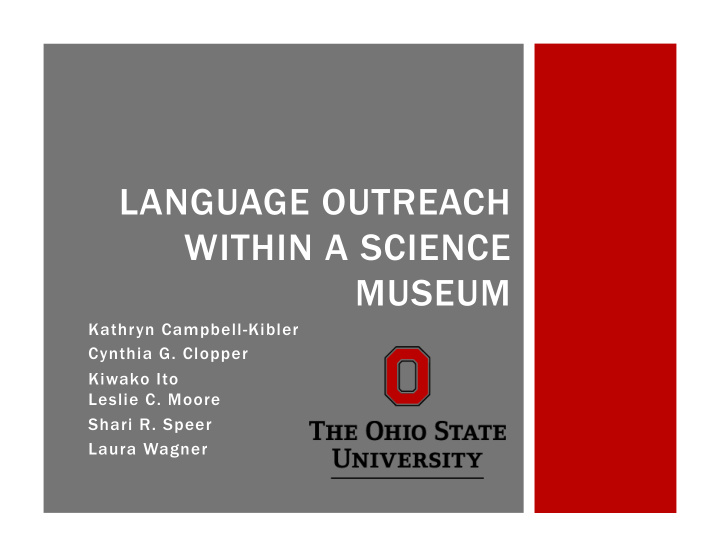



LANGUAGE OUTREACH WITHIN A SCIENCE MUSEUM Kathryn Campbell-Kibler Cynthia G. Clopper Kiwako Ito Leslie C. Moore Shari R. Speer Laura Wagner
THE LANGUAGE POD
WHERE WE ARE
WHO WE ARE � Cross-departmental consortium of faculty at OSU who all work on language – The Buckeye Language Network � Collectivist Organization: No fee to work in the pod but each contributes time and sweat
MISSION Inf Inform orm and e and excit cite pe people ople about about language language! Research Education Outreach
SOME SPECIFIC GOALS � Researchers § Collect data § Help them connect their work to the broader public � Students § Teach them HOW to communicate about language to the public and WHY that is important to do § Get them interested in linguistics and language research � Public § Teach people true things about how language works and show how researchers study language § Use language as a way to promote scientific thinking in general
RESEARCH � Fully Equipped Lab § 2 eye-trackers, 3 PC’s, 7 iPads, and lots of other stuff § IRB umbrella protocol to recruit visitors � Data Collection § From Ling, Psych, CSE, Speech & Hearing, Music, English § Looking at online prosody, regional dialect, speech processing, semantic acquisition, and more! § Over 3000 visitors run as participants in 2014 � The Research IS a Form of Outreach! § COSI bills us as “Research in Real Time” § Watching research happen and/or being in a study is a great way to show how language science works
EDUCATION � The Pod Course § Ohio State course for undergrads and grad students § Training in principles of informal science learning § Students conduct outreach demonstrations with visitors and assist in recruiting participants § Feeder course for RA positions for many students � NSF REU Site: The Science of Language & The Language of Science § Summer internship program for the next 3 years
OUTREACH � Research is a form of outreach! � Pod Fairs § Several faculty come to the museum and conduct (new) demonstrations � Interactive Demonstrations § Canonical form of outreach § Very similar to what others have done at other public venues, and also to what the COSI museum staff do for other sciences
INTERACTIVE DEMONSTRATIONS � Cover a range of topics: § Speech Perception & Production § Phonological Structure § Reading & Writing § Language Diversity § Language Acquisition § Language & Cognition � Many Formats/Multi-Modal § Ipad games, Videos, Models, Pictures, Bodies � Supported by written guidelines § Under constant development and improvement
EXAMPLE: SIGN LANGUAGE NUMBERS � Sign languages are languages � Materials: Your hands! � Pitch: Wanna learn to count to 10 in sign language? � Interaction: Teach visitors to count to 10 in ASL and BSL � Take-Home Messages: § Sign languages are NOT pantomimes! They have structure and rules! And different sign languages have different rules. § Sign languages are not just manual versions of a spoken language. Even though people in the UK and USA speak English, ASL and BSL are different. § Some signs are iconic (or at least transparent) but most signs are not. You need to learn ASL just like you’d learn any other language.
EXAMPLE: STROOP TASK � Reading is an automatic process BLUE � Materials: $1 iPad App � Pitch: Wanna play a game? � Interaction: Have visitor play the game and feed thought questions about it. � Thought Questions: � Take-Home Messages: § How can you improve? (Focus on letters not words; § You can’t stop turn iPad upside down; take yourself from off your glasses) reading – even § Who would be good at this when you want to! game? § Explain inhibitory (Children just learning to control as a general read, people who don’t read cognitive process. English, bilinguals)
FUNDING Thanks for material support: � OSU Department of Linguistics � OSU Department of Psychology � OSU Office of Research � OSU College of Arts and Sciences � OSU Center for Cognitive and Brain Sciences � BETHA grant from the Battelle Foundation � OSU Engagement Impact Grant � NSF REU Site Grant
THANK YOU! Email: bln@osu.edu Website: bln.osu.edu/LanguagePod.php Facebook: www.facebook.com/BLNLanguagePod
Recommend
More recommend